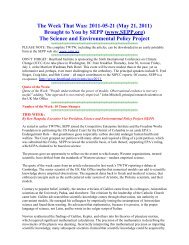Nature, Not Human Activity, Rules the Climate - Science ...
Nature, Not Human Activity, Rules the Climate - Science ...
Nature, Not Human Activity, Rules the Climate - Science ...
You also want an ePaper? Increase the reach of your titles
YUMPU automatically turns print PDFs into web optimized ePapers that Google loves.
Rahmstorf, S., et al. 2007. Recent climate observationscompared to projections. <strong>Science</strong> 316(5825): 709.Reiter, P., 2005. The IPCC and technical information.Example: Impacts on human health.http://www.publications.parliament.uk/pa/ld200506/ldselect/ldeconaf/12/12we21.htmRobinson, A.B., N.E. Robinson, and W. Soon 2007.Environmental effects of increased atmospheric carbondioxide. Journal of American Physicians and Surgeons 12:79-90.Robock, A., et al. 2007. Climatic consequences of regionalnuclear conflicts. Atm. Chem. Phys. 7: 2003-2012.Santer, B.D., et al. 1996. Towards <strong>the</strong> detection andattribution of an anthropogenic effect on climate. Clim. Dyn.12: 79-100.Santer, B.D. and 23 coauthors 2005. Amplification of surfacetemperature trends and variability in <strong>the</strong> tropical atmosphere.<strong>Science</strong> 309: 1551-1555.Scafetta, Nicola and B.J. West 2007. Phenomenologicalreconstructions of <strong>the</strong> solar signature in <strong>the</strong> Nor<strong>the</strong>rnHemisphere surface temperature records since 1600. Journalof Geophysical Research, 112, D24S03,doi:10.1029/2007JD008437.Schlesinger, M.E. and N. Ramankutty 1994. An oscillation in<strong>the</strong> global climate system of period 65-70 years. <strong>Nature</strong> 367:723-726.Schwartz, S.E, 2007. Heat capacity, time constant, andsensitivity of Earth’s climate system. J. of Geophys. Res.DOI:10.1029/2007JD008746.Schwartz, S.E., R.J. Charlson, and H. Rodhe 2007.Quantifying climate change - too rosy a picture? <strong>Nature</strong> 2:23-24.Seitz, F. 1996. A Major Deception on Global Warming. TheWall Street Journal, June 12.Senior, C.A. and J.F.B. Mitchell 1993. Carbon dioxide andclimate: The impact of cloud parameterization. J. Clim. 6:393-418.SEPP 1992. The Greenhouse Debate Continued: An Analysisand Critique of <strong>the</strong> IPCC <strong>Climate</strong> Assessment. ICS Press,San Francisco, CA.SEPP 1997. The Scientific Case Against <strong>the</strong> Global <strong>Climate</strong>Treaty. www.sepp.org/publications/ GWbooklet/GW.html[Also available in German, French, and Spanish].SEPP 2002. The Kyoto Protocol is <strong>Not</strong> Backed by <strong>Science</strong>.<strong>Science</strong> and Environmental Policy Project, Arlington VA.Shaviv, N. J.. 2002. Cosmic ray diffusion from <strong>the</strong> galacticspiral arms, iron meteorites, and a possible climaticconnection? Phys. Rev. Lett. 89, 051,102.Shaviv, N.J. 2005. On climate response to changes in <strong>the</strong>cosmic ray flux and radiative budget. J. Geophys. Res. 110:A08105.Shaviv, N. J. and J. Veizer. 2003. A celestial driver ofphanerozoic climate? GSA Today, 13, 4-11.Shindell, D.T. 2001. <strong>Climate</strong> and ozone response toincreased stratospheric water vapor. Geophys. Res. Lett. 28:1551-1554.Shukla, J. 2007. Monsoon mysteries. <strong>Science</strong> 318: 204-205.Singer, S.F. 1958. Cosmic-ray time variations produced bydeceleration in interplanetary space. Nuovo Cimento 8,Supple. II: 334-341.Singer, S. F. 1971. Stratospheric water vapour increase dueto human activities. <strong>Nature</strong> 233: 543-547.Singer, S. F. 1997, 1999. Hot Talk Cold <strong>Science</strong>. TheIndependent Institute, Oakland CA.Singer, S. F. 1999. <strong>Human</strong> contribution to climate changeremains questionable. Also, Reply. Eos [Transaction AGU],80, 33, 186-187 and 372-373.Singer, S. F. 2000. <strong>Climate</strong> policy – From Rio to Kyoto apolitical issue for 2000 and beyond. Essays in Public Policy102. Hoover Institution, Stanford University, Stanford CA.Singer, S. F. 2001. Disparity of temperature trends ofatmosphere and surface. Paper presented at 12th Symposiumon Global <strong>Climate</strong> Change, Amer. Meteorol. Soc.,Albuquerque NM.Singer S. F. 2005a. Are sea surface temperature (SST) trendsreal. Abstract for <strong>the</strong> AGU Joint Assembly, May 25, 2005,New Orleans LA.Singer S. F. 2005b. A closer look at sea surface temperaturetrends: How effective is greenhouse (GH) warming of SST?Presentation at CCSP Workshop, November 14, 2005.http://www.climatescience.gov/workshop2005/posters/P-GC2.9_Singer.S.pdf.Singer, S. F. 2006. How effective is greenhouse warming ofsea surface temperatures? In A. Zichichi and R. Ragini(eds.). International Seminar on Nuclear War and PlanetaryEmergencies. Climatology: Global Warming. WorldScientific Publishing Company, Singapore. pp. 176-182.Singer, S.F. et al. 1997. Comments on ‘Open Letter to BenSanter.’ Bull Am Meteorolol Soc. 78: 81-82.Singer, S. F., R. Revelle and C. Starr 1991. What to do aboutGlobal Warming: Look Before You Leap. Cosmos 1:28-33.Singer, S. F. and D. Avery 2007. Unstoppable GlobalWarming: Every 1,500 Years. Rowman & LittlefieldPublishers, Inc.Smith, D.M., et al., 2007. Improved surface temperature35





